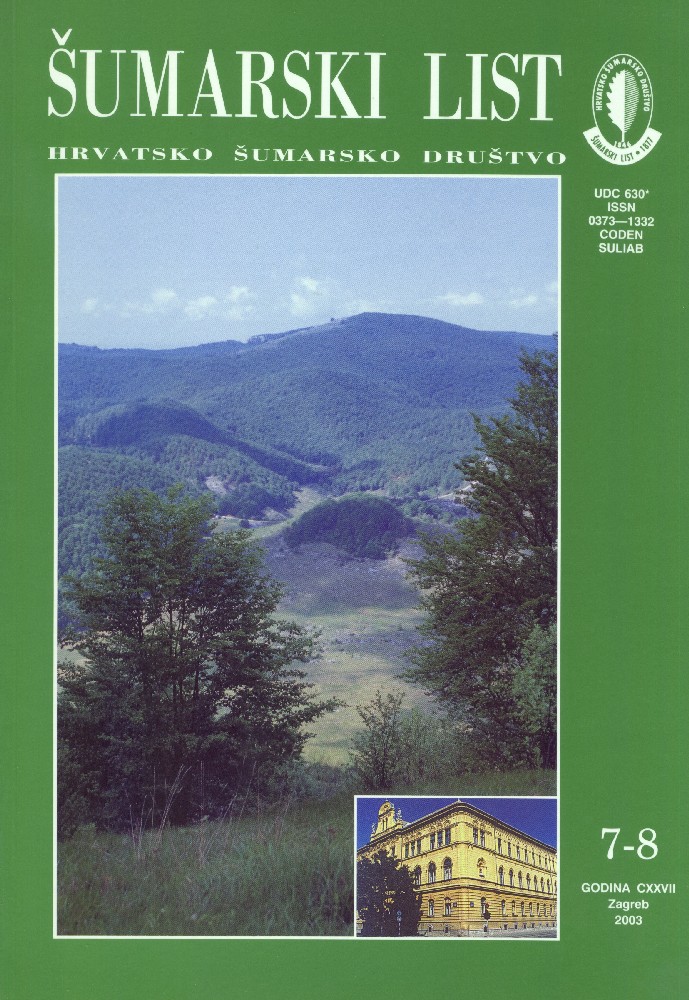
broj: 7-8/2003
pdf (23,8 MB) |
|
||||||||||||||
| IZVORNI ZNANSTVENI ČLANCI | ||
| Sabo, A. | UDK 630* 462 (001) | |
| Damaging Trees in Timber Skidding by TIMBERJACK 240C in Seleciton Forest Stands pdf HR EN | 335 | |
| Summary: This paper gives a survey of the data collected in investigating the damage caused to the stand in skidding coniferous roundwood by Timberjack 240C in the selection forests of Gorski Kotar. The research was carried out at two sites (A, B) in Delnice Forest Administration. The indicators of the damage caused to standing trees are as follows: the surface of the damaged bark, location of the tree in the stand, place of damage, type of damage, cause of damage, economic importance and state of the damaged tree. The intensity of damaging is expressed by the ratio of damaged trees and the number of the remaining trees. The distance between the damaged trees and the strip road was measured as well as the slope of the damaged tree micro-terrain and the volume of the damaged seedling and young growth. Timber skidding caused damage to 1.84 % (A) and 1.77 % (B) of the remaining trees. The thickness degree of the majority of the damaged trees ranged between 12.5 cm and 22.5 cm. At the site A the average damage height was 63 cm from the ground and at site B 75 cm. The average damage surface was 1.7 times (A) and 1.4 times (B) larger on fir trees than on beech trees. The highest number of damages occurred on root collars - 90 % in A and 85 % in B. The most frequent type of damage in both stands was the peeled bark (97 % in A and 94 % in B). The highest number of damages was caused by load - 97 % (A) and 92 % (B). In view of the economic importance, selected and useful trees were mostly damaged in timber skidding. Hard and very hard condition of damaged trees was found in 95 % (A) and 94 % (B). The average distance of the damaged tree from the strip road was 7 m at the site A and 6.2 m at the site B. The average slope of the damaged tree micro-terrain was 10.6 % (A) and 7.9 % (B). At the site A, seedling and young growth were mostly damaged up to the height of 1.3 m and at the site B above the height of 3.0 m. By a series of indicators of stand damages it has been confirmed that stand and terrain conditions are the crucial damaging factors, provided that other conditions are equal - technology and methods, means of work and operators. Thus the need has been confirmed again for developing the stand working classification aimed at modeling the standardized dynamic weights and measures for evaluating the quality of the work performed in forests. Without such solutions it will be impossible to up-grade (or even to introduce) the evaluation system for establishing the complex efficiency of wood production and other working (production) processes in forestry. Key words: timber skidding; stand damaging; damage; economic importance; tree damage | ||
| Ballian, D. | UDK 630* 165 (001) | |
| assessment of genetic variability of silver fir (Abies alba mill.) with cpDNA analysis in the part of natural populations of Bosnia and Herzegovina and Croatia pdf HR EN | 347 | |
| PRETHODNO PRIOPĆENJE | ||
| Vučetić, V., Vučetić, M. | UDK 630* 111 + 181.8 | |
| Phenological Characteristics in the Area of Zavižan pdf HR EN | 359 | |
| PREGLEDNI ČLANCI | ||
| Ištvanić, J. | UDK 630* 822 (Fagus sylvatica L.) | |
| Beech (Fagus Sylvatica L.) Sawmill Processing in Croatia pdf HR EN | 373 | |
| Zelić, J., Pauča, B. | UDK 630* 569 | |
| The Contribution to Determining Basic Normals for Mixed Selection Forest of Beech and Silver Fir in Pannonian Mountains pdf HR EN | 389 | |


